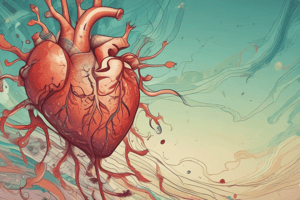Podcast
Questions and Answers
What is the primary function of lecithin-cholesterol acyl-transferase (LCAT) in HDL metabolism?
What is the primary function of lecithin-cholesterol acyl-transferase (LCAT) in HDL metabolism?
- Synthesize nascent HDL
- Transfer of fatty acids to LDL
- Catalyze the esterification of free cholesterol (correct)
- Degrade cholesteryl esters in hepatocytes
How does HDL primarily acquire free cholesterol from other sources?
How does HDL primarily acquire free cholesterol from other sources?
- By accepting cholesterol from circulating lipoproteins (correct)
- By receptor-mediated endocytosis only
- By direct synthesis in the intestines
- Through bile acid excretion
What happens to HDL particles after they uptake free cholesterol?
What happens to HDL particles after they uptake free cholesterol?
- They become spherical due to added cholesterol (correct)
- They lose their apoproteins
- They remain as flat particles
- They are immediately excreted from the body
What role does apoprotein A play in HDL metabolism?
What role does apoprotein A play in HDL metabolism?
What is the ultimate fate of cholesteryl esters taken up by HDL in the liver?
What is the ultimate fate of cholesteryl esters taken up by HDL in the liver?
Flashcards are hidden until you start studying
Study Notes
Metabolism of HDL
- High-density lipoproteins (HDL) are synthesized in the liver and intestine as nascent HDL.
- Nascent HDL contains free cholesterol, phospholipids (primarily lecithin), and apoproteins such as A, CII, and E.
Role of LCAT in HDL metabolism
- Lecithin-cholesterol acyl-transferase (LCAT) is a plasma enzyme that catalyzes the esterification of free cholesterol using fatty acids from lecithin.
- LCAT activity is promoted by apoprotein A.
- HDL can accept free cholesterol from other circulating lipoproteins and peripheral cell membranes.
- Any free cholesterol taken up by HDL undergoes esterification through the action of LCAT, resulting in spherical HDL particles.
- Spherical HDL particles, containing cholesteryl esters, enter hepatocytes via receptor-mediated endocytosis.
- Within the liver, cholesteryl esters are degraded to cholesterol.
- The cholesterol derived from cholesteryl esters is utilized for bile acid synthesis, lipoprotein formation, or excreted into bile.
Cardioprotective function of HDL
- HDL is referred to as "good cholesterol" due to its positive role in lipid metabolism and cardiovascular health.
Studying That Suits You
Use AI to generate personalized quizzes and flashcards to suit your learning preferences.



